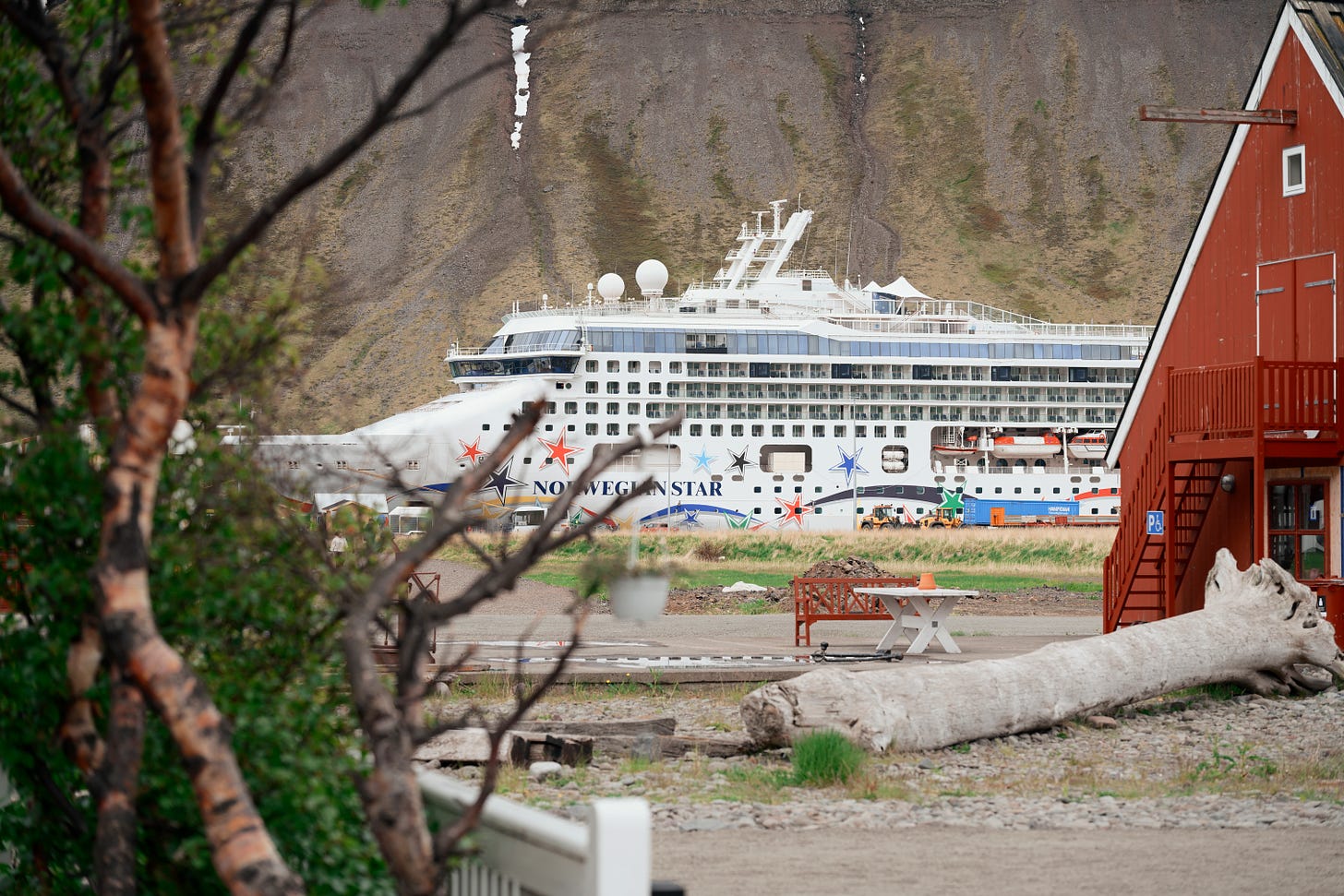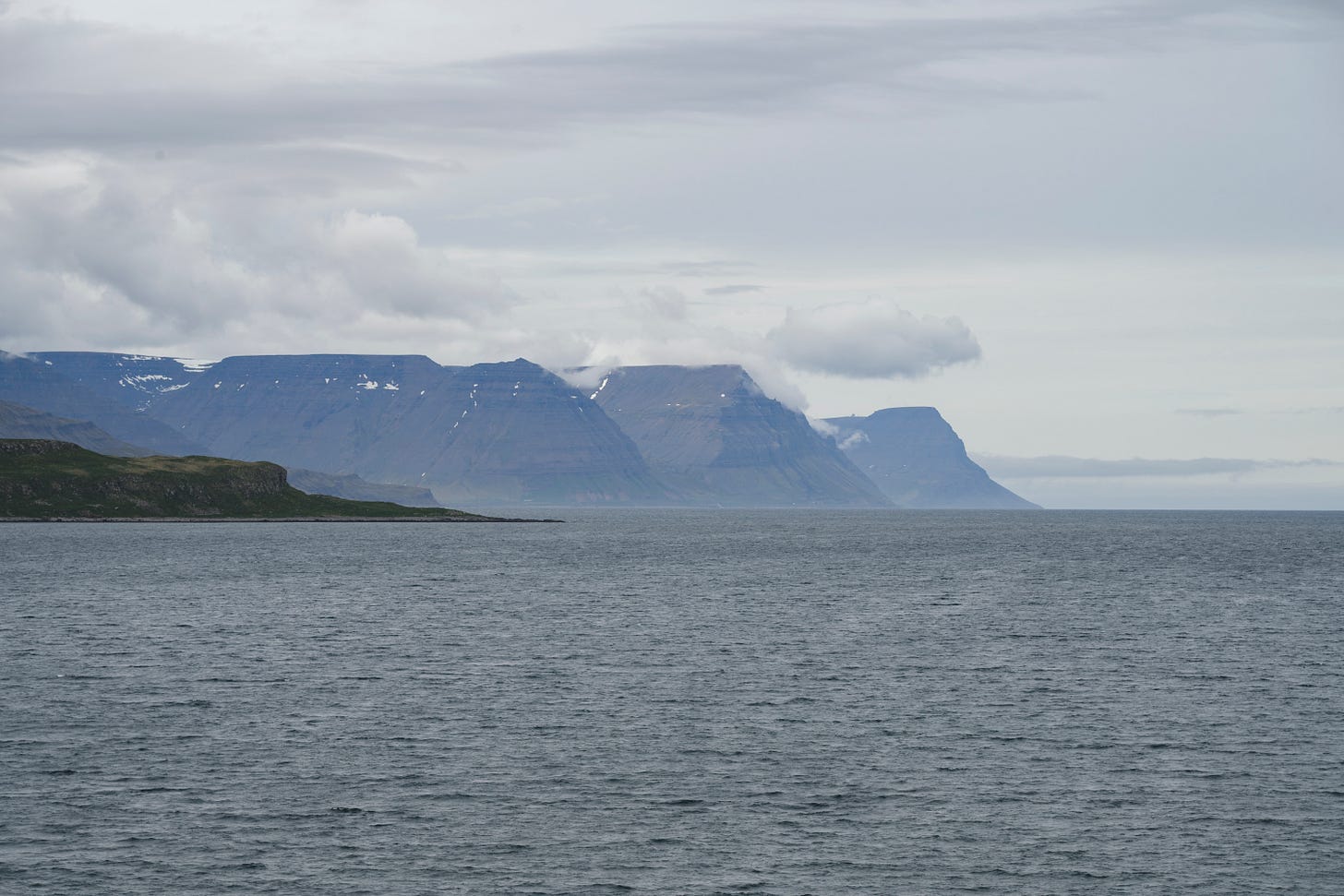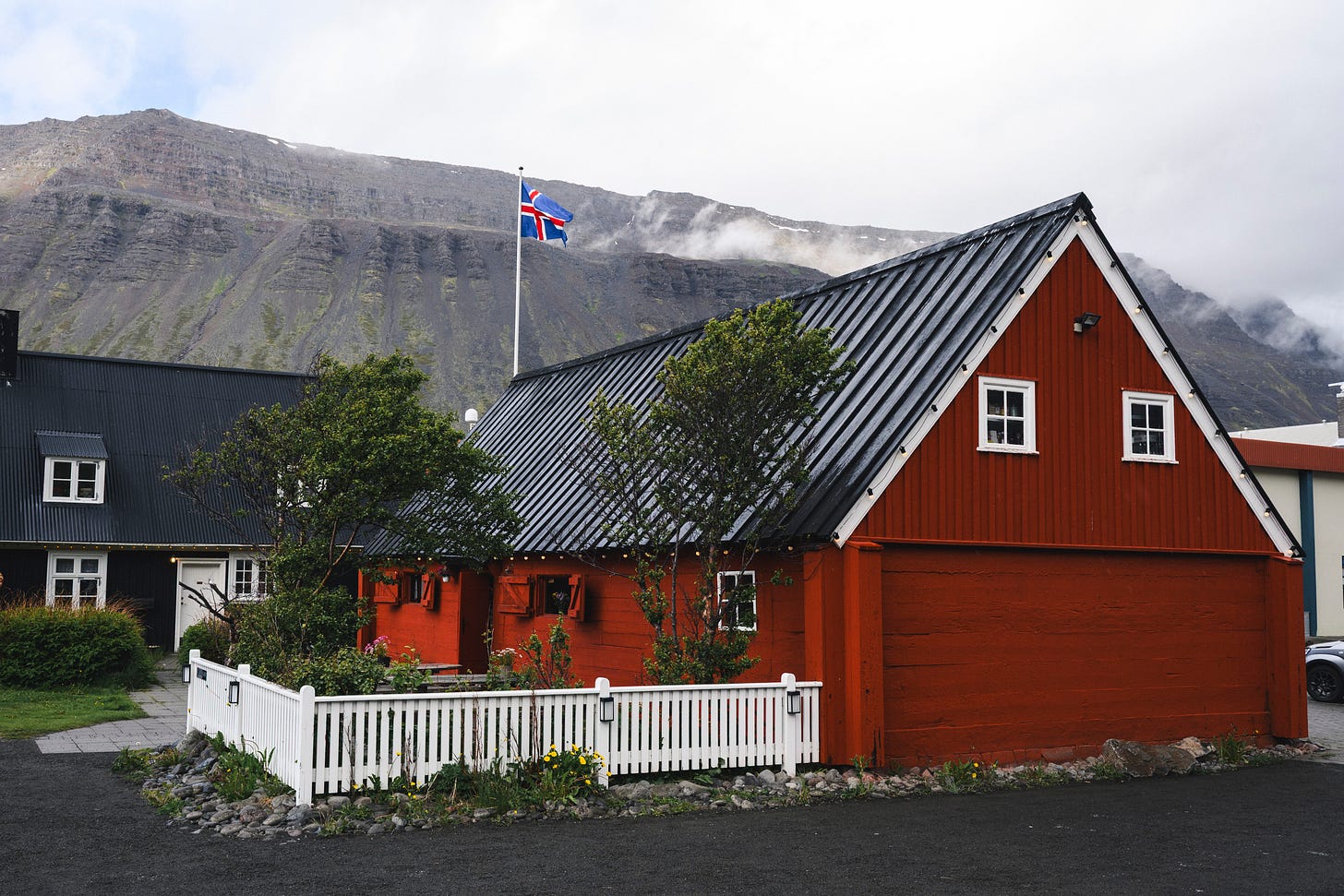Feasting at the Edge of the World (Part 1)
At Tjöruhúsið, a family restaurant in Iceland's remote Westfjords, the line between survival and cuisine disappears with each cast iron pan of fish.
“Do you ever feel like you’re performing some kind of viking fantasy for them?” I asked in jest. We were taking a quick coffee and smoke break outside the restaurant between lunch seatings. It was late May but the air was crisp, still decidedly spring in Iceland.
As we stood outside the red tavern, a horn sounded in the distance. The boat was docked within eyesight on the other side of the harbor. It was a cruise ship day, though that hardly needed announcing. Tourists were already swarming downtown, cosplaying as hikers and adventurers donning expensive yet unscathed parkas and hiking gear. I looked on, doubting much hiking would be had that day - or any other, for that matter.
Haukur responded with a slight chuckle and a long drag from his cigarette. Then, a swig of coffee. He’s tall, over six feet, with a few small tattoos on his arms, a mustache and long sideburns. His garb - a graphic t-shirt, black leather apron, and a trapper hat - matched his scruffy, relaxed character.
“Sometimes,” he eventually said with a wry smile, “I actually don’t have a defined role during the morning shifts, I’m just helping out where I can. We have to be flexible.” He took another drag of his cigarette.
As I watched the restaurant’s production, I found Tjöruhúsið walking a delicate line. It’s become the de facto eatery of Ísafjörður’s burgeoning tourism industry, serving up the most incredible food you’ll have in the Westfjords - and Iceland writ large. And yet it’s a deeply personal reflection of Haukur and his family.
“It’s quite the crowd here,” I said, looking toward the old house’s window, “you have cruise ship goers, some guys in blazers, and others in Carhartt jackets...”
“Oh yeah, this is the Federation of Icelandic Municipalities,” Haukur replied with an official but sarcastic tone, gesturing towards the smartly dressed Icelanders finishing their lunch.
As more folks were piling through the doors of Tjöruhúsið, Haukur ashed his smoke and went to greet them. It was time for the second seating.
Earlier that day, I met up with Haukur on a typical morning in the Magnússon household. It was a small house in Ísafjörður, the largest city in the remote Westfjords region of Iceland, home to fewer than 3,000 residents.
The place was tidy but with signs of a four-year-old’s presence and the parents’ quiet struggle. Haukur was responding to reservation requests - a barrage of emails, Facebook, and WhatsApp messages - while his wife Shayan was rushing out the door to get to the restaurant. Haukur had invited me over to his house for a quick cup of coffee before we went shopping for the daily provisions.
“We’re a very manic-depressive country,” he said, closing his laptop. We were sitting at a small table in his living room while Steve Reich’s Pulse/Quartet sounded on the record player. “We work in spurts. In the summer you’re awake and you get food, and in the winter you hibernate and try not to kill yourself.” He has dry, deadpan humor but speaks with a rhythmic pattern.
“It’s been like that for most of the country’s lifetime,” he continued. “When there’s fish to be caught, you catch them. When there’s food, you eat it. We go all in without much foresight and planning.”
This manic-depressive rhythm is written into the landscape itself. Ísafjörður sits between two large mountains, each rising steeply out of the ocean to a flat-topped basalt summit, then plunges back into the cold waters of the North Atlantic. In winter, the sun hardly rises above the towering cliff tops, keeping the town in a state of perpetual darkness. And during the summer months, the midnight sun keeps the lights on for all hours of the day. You get the sense that it used to be, and probably still is, a difficult life. So what might appear as manic-depressive, is actually a resourcefulness and adaptability required to survive.
As we sit and chat about Iceland and its people, Haukur walks me through how his parents came to run Tjöruhúsið. After watching Rambo for the first time at a friend’s house, his dad, convinced that he witnessed the future, opened Ísafjörður’s first video rental store. A few years later, around the late 1980s, they opened “The Fisherman’s Room,” a restaurant catering to the workers in Ísafjörður’s booming fishing industry. A few years after that, they went on to run a fish moving business, helping unload boats full of fish to be processed elsewhere.
The story of Iceland and its people has always been tied to the riches of the sea. First it was cod, the fish that built the country during its formative years. Then came the herring years of the 20th century, which transformed small villages into boomtowns practically overnight. Fishermen made fortunes and subsequently lost them on these tiny fish, as overfishing decimated the herring population. The pattern continued with capelin in the 1970s, another small fish that promised riches before its stock was also depleted.
By 1984, fearful of dwindling fish stocks, Iceland introduced a controversial and complex fishing quota system. In 1990, changes to the quota system allowed for larger corporations to buy up smaller operations. Within a few years, the effects of consolidation rippled through the Westfjords, and small towns built on the fishing industry began to shrink.
In 2003, someone from the township approached Haukur’s parents about taking over the old tar house (tjöruhús, in Icelandic) in Ísafjörður. It was an old historic building near the water where tar would be prepared for use in the region’s fishing industry - waterproofing boats, protecting sails, and reinforcing ropes or rigging. His dad was still involved in the fish moving business, but seeing that industry in decline, they decided to open the eponymous restaurant, Tjöruhúsið. At first, it was a small cafe with a modest menu - fish soup, coffee, and cakes made by his grandma. As the place grew, his dad decided to bring in some of the fish and cook it for the cafe.
“People thought the fish was really good. And my mom, who’s also an amazing chef, is kind of this master of vibes,” Haukur remembered. “Since the beginning, it felt like going to dinner at my parents’ house. So they kept making food and people kept coming.”
By year three, Tjöruhúsið was gaining popularity and momentum in the area. But there was no business plan or structure. All the decisions for the restaurant were just made by intuition and reaction, channeling some of that Icelandic resourcefulness. His parents could cook and curate the space, but the demand started to outpace what they could offer.
“I remember coming home one summer, 2005 or 2006, to an empty house and sour milk in the fridge,” he recalled. “I went down to the restaurant and my family was almost catatonic, working for two weeks straight. So I put on an apron and started helping.”
Technically, I first met Haukur four years ago, though I’m not sure he remembered me. It was in May of 2021, right as Iceland was starting to welcome tourists back from a pandemic-induced slumber.
Finding Tjöruhúsið for the first time was a deeply romantic experience. As I stood outside the old tar house, the mountains outside Ísafjörður rose like ramparts from the water’s edge. The faces were stern, as years of erosion had drawn deep, brush stroke-like grooves into them. Tracing the ridges toward the sky, snow and moss clung to each crevice, eventually disappearing into the low-hanging clouds and obscuring the ridge line. I felt like I was at the edge of the world, or at least damn close to it.
The building itself looked like an old tavern or barn plucked from the Middle Ages. Inside, long wooden tables sat on top of creaky wood floors, while thick ceiling beams threatened anyone over six feet tall. Within minutes of stepping inside, the whimsy and romance of travel captured my imagination. I was convinced town halls and great feasts were once held between the same walls.
The meal was spectacular. It started with a seafood soup - langoustine and cod with a creamy tomato base. As I slurped, the kitchen started to bring out bowls and plates full of salads and side dishes, placing them on a large table at the front of the room. A few minutes later, a procession of cast iron skillets emerged from the kitchen leaving behind a trail of steam. The sizzle and crackle of fat rang through the air as the pans were set on the front table.
Then Haukur called all the guests, only a few of us at the time, up to form a line, buffet style. He stood at the front, pointing at and naming each dish as we progressed through. While I was waiting, I could hear him reciting the different fish and their preparations, scooping them out of the cast iron and onto eager plates - wolfish, lemon sole, halibut, fresh cod, salt cod, cod tongue, plaice, salmon, lingcod, and ocean perch. With each name, I imagined some crusty old Icelandic fisherman casting his line in the nearby harbor not 100 yards from where I was standing. This was how it must’ve been, I thought to myself.
There was something about Tjöruhúsið that was, to borrow from an overused tourist cliché in Iceland, otherworldly. It defied the conventional rules of a fine dining or elite restaurant. There was no pretension, no theater. No white table cloths or tasting menus with wine pairings. You wouldn’t really call it delicate or refined. Instead there was this very palpable organic energy unlike anything else I’ve experienced.
Standing there in line, watching steam rise from the skillets, I thought I had found the platonic ideal of local food - a restaurant serving fish caught just outside its door. The kind of place that makes for great copy about tradition and terroir. But four years later I would learn that, while tourists like me were busy romanticizing authenticity, Tjöruhúsið’s connection to place ran deeper than any farm-to-table manifesto could capture. It wasn’t about proximity to ingredients or preserving tradition, but something else entirely.
To be continued…









We have visited Iceland for birds and wildlife flowers ... now I plant to go back soon and eat at this splendid place. Wonderful. Thanks.
I would love to have that meal you described at the end.
Also, and you're going to hate me, we visited Ísafjörður last year on a cruise ship! We even went for a short hike. 😎